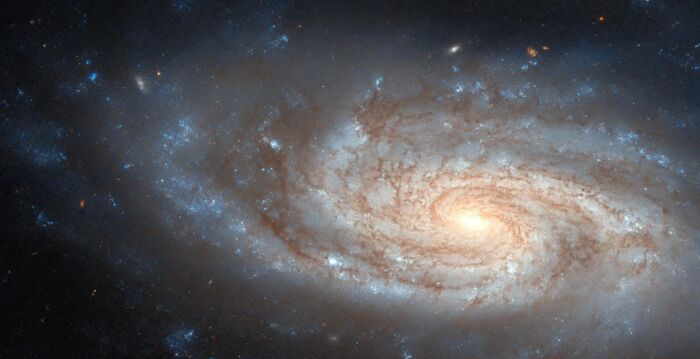[The Epoch Times, 4 Lùnastal, 2024](Epoch Times reporter Chen Juncun said) An image taken by NASA’s Hubble Space Telescope shows the classic spiral galaxy NGC 3430. The galaxy has clear open spiral arms that astronomers used to define the classification of galaxies. .
The NASA website published this image on July 26. The pictured spiral galaxy NGC 3430 is located in the constellation Leo Minor, 100 million light-years away from Earth.
There are several other nearby galaxies just outside the frame of the image, including one close enough to gravitationally interact with NGC 3430 and trigger the formation of some of the stars in the galaxy . In the image, these stars are bright blue patches near but outside the main spiral structure of the galaxy.
NGC 3430 has a bright core from which spiral arms appear to extend like a windmill. Dark dust lanes and bright star-forming regions help explain these spiral arms.
NGC 3430’s bright appearance may be one of the reasons American astronomer Edwin Hubble used it to help define his classification of galaxies. Hubble described about 400 galaxies in a paper in 1926. Classified by appearance, these galaxies can be classified into spiral galaxies, barred spiral galaxies, lenticular galaxies, elliptical galaxies or irregular galaxies.
This simple typology was so influential that astronomers still use the Hubble classification to develop detailed plans. The spiral arms of NGC 3430 are open and clearly defined, but there is no apparent strip structure in the center.
The Epoch Times previously reportedspiral galaxies appear to form bars at their centers as they mature, but these bars disappear if the mass near the bars becomes unstable.
In addition, on August 2, the NASA website also released a photo of the dwarf elliptical galaxy IC 3430. Different from NGC 3430, IC 3430 does not have spiral arms or striped structures.
Dwarf elliptical galaxy IC 3430 captured by NASA’s Hubble Space Telescope. (NASA)
IC 3430 is located in the constellation Virgo, 45 million light-years away from Earth, and is part of the Virgo Cluster. The Virgo Cluster is a rich collection of galaxies, large and small, many of which are very similar in type to the small galaxy IC 3430.
Like larger elliptical galaxies, IC 3430 has a smooth flat appearance, but lacks recognizable features such as spiral arms or bars, and most of the gas necessary for star formation.
Interestingly, IC 3430 has a core of hot, massive blue stars, which is unusual in elliptical galaxies. This indicates recent star formation activity.
Astronomers believe that the pressure generated by the galaxy through the gas in the Virgo Galaxy Cluster, ignited the gas in the center of IC 3430, and then created relatively new stars.
Dwarf galaxies are simply galaxies with fewer stars, usually less than a billion, but often enough that they reproduce in miniature the same form as larger galaxies. For example, there are dwarf elliptical galaxies like IC 3430, as well as dwarf irregular galaxies and dwarf spiral galaxies.
Editor-in-Chief: Sun Yun

